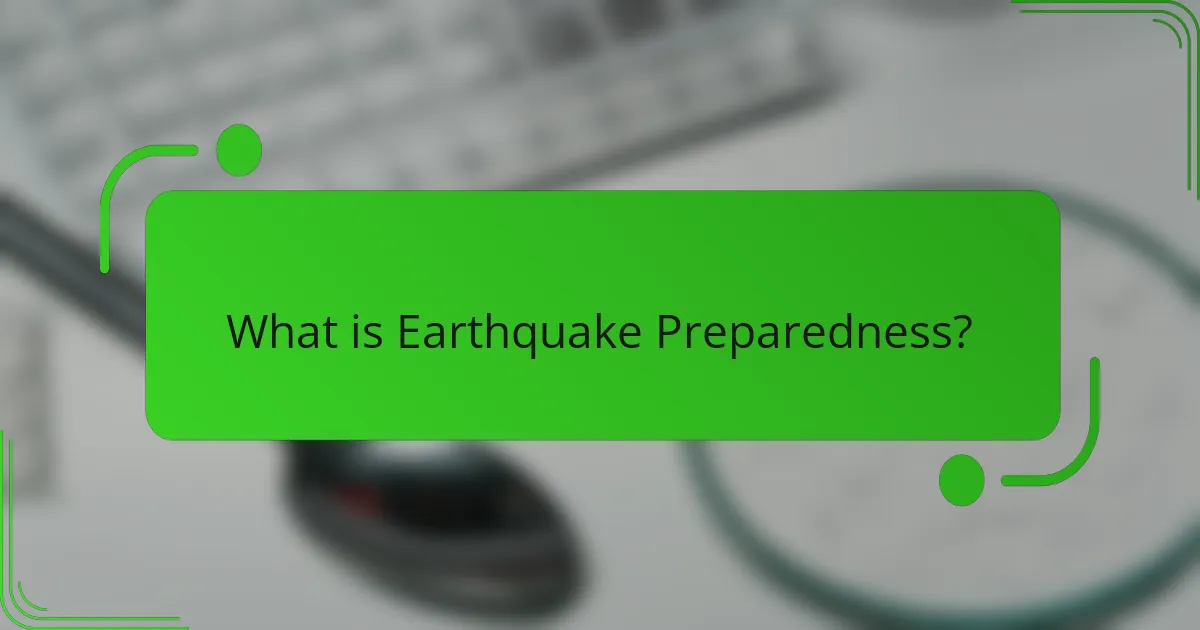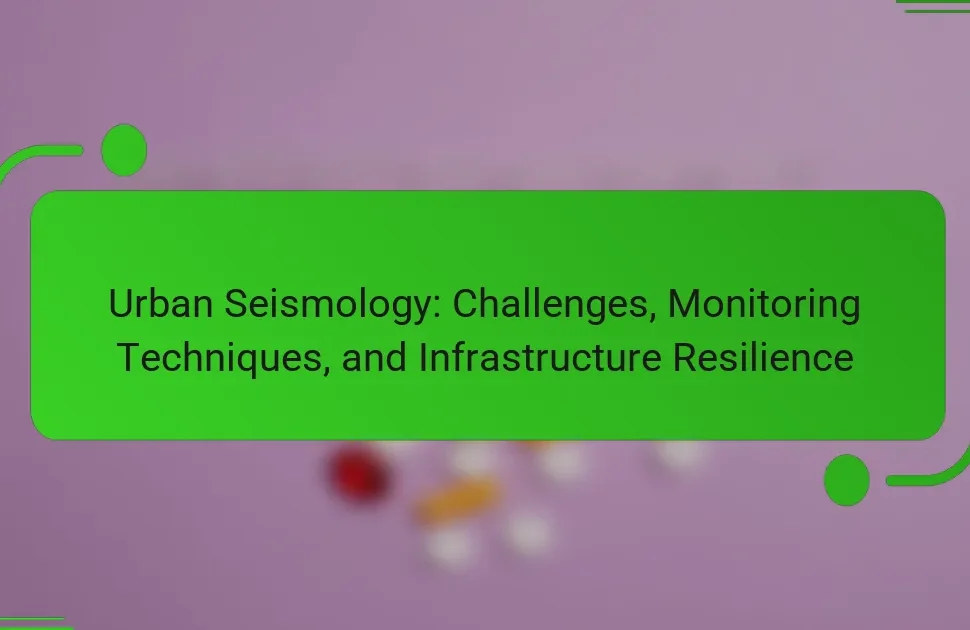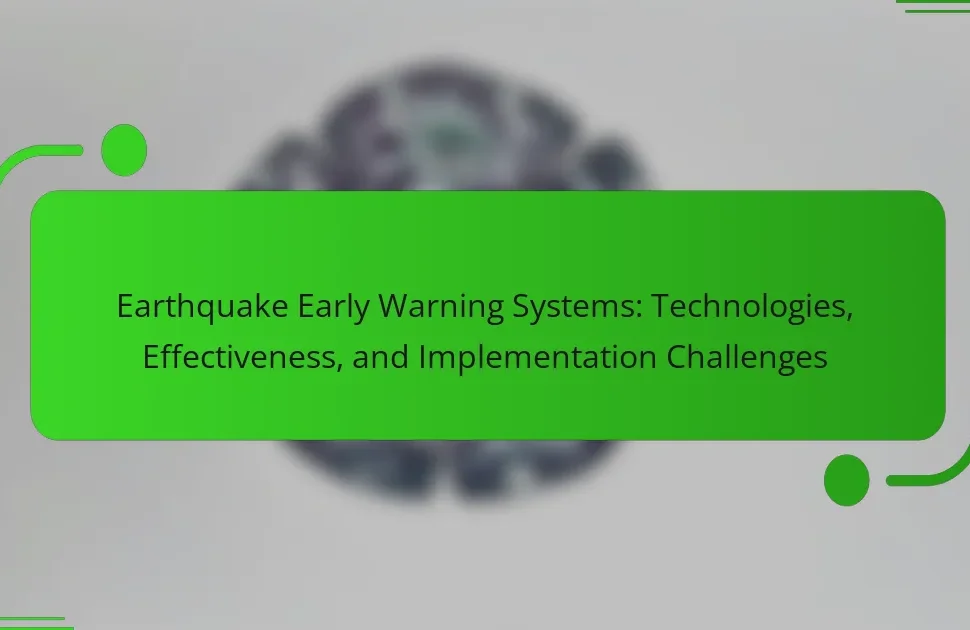Earthquake preparedness encompasses the proactive measures taken to ensure safety during seismic events. Key aspects include the development of emergency plans, securing heavy furniture, and assembling disaster supply kits. Additionally, community education about earthquake risks and response strategies plays a crucial role in enhancing resilience. According to the Federal Emergency Management Agency (FEMA), effective preparedness can significantly reduce injuries and property damage. The article will explore various preparedness activities, such as drills, community meetings, and the distribution of informational materials, all aimed at minimizing the impact of earthquakes.

What is Earthquake Preparedness?
Earthquake preparedness refers to the proactive steps taken to ensure safety during an earthquake. This includes creating emergency plans, securing heavy furniture, and assembling disaster supply kits. Preparedness also involves educating communities about earthquake risks and response strategies. According to the Federal Emergency Management Agency (FEMA), having a plan can significantly reduce injuries and property damage. Preparedness activities can include drills, community meetings, and distributing informational materials. The goal is to enhance resilience against earthquakes and minimize their impact.
Why is Earthquake Preparedness important for communities?
Earthquake preparedness is crucial for communities to minimize damage and save lives during seismic events. Preparedness enables individuals and families to respond effectively when an earthquake occurs. Communities that engage in preparedness training can reduce panic and confusion. According to the Federal Emergency Management Agency (FEMA), well-prepared communities experience fewer injuries and fatalities during earthquakes. Preparedness also includes developing emergency plans and conducting drills. These actions ensure that residents know how to react and where to seek shelter. Furthermore, communities that invest in infrastructure resilience can withstand seismic impacts better. Statistics show that communities with comprehensive preparedness programs recover faster after disasters.
What are the potential impacts of earthquakes on communities?
Earthquakes can have devastating impacts on communities. They can cause significant damage to infrastructure, including buildings, roads, and bridges. In 1994, the Northridge earthquake in California resulted in over $44 billion in damages. Loss of life is another critical impact; thousands can be injured or killed during a major quake. For example, the 2010 Haiti earthquake led to approximately 230,000 deaths. Economic disruption is also prevalent, as businesses may close and employment opportunities diminish. Additionally, communities often face long-term psychological effects, including trauma and anxiety among residents. Recovery can take years, affecting social cohesion and community resilience.
How can preparedness reduce the risks associated with earthquakes?
Preparedness can significantly reduce the risks associated with earthquakes. It involves planning, training, and resource allocation. Prepared communities are more resilient during seismic events. They can respond quickly and effectively to minimize damage. For example, having emergency kits and evacuation plans saves lives. According to FEMA, communities with preparedness programs experience fewer injuries and fatalities. Regular drills enhance public awareness and readiness. Preparedness also includes retrofitting buildings to withstand earthquakes. Research shows that such measures can reduce structural damage by up to 50%.
What are the key components of Earthquake Preparedness?
The key components of earthquake preparedness include creating an emergency plan, assembling an emergency kit, securing your home, and educating yourself and your community. An emergency plan outlines actions to take before, during, and after an earthquake. An emergency kit should contain essential supplies like water, food, first aid, and tools. Securing your home involves reinforcing structures and anchoring heavy furniture to prevent damage and injuries. Education on earthquake risks and safety measures enhances awareness and readiness within the community. The Federal Emergency Management Agency (FEMA) emphasizes these components as critical for effective earthquake preparedness.
What safety measures should individuals take before, during, and after an earthquake?
Individuals should take specific safety measures before, during, and after an earthquake. Before an earthquake, securing heavy furniture and appliances can prevent them from tipping over. Creating an emergency kit with food, water, and first-aid supplies is essential. Developing a family communication plan ensures everyone knows what to do. During an earthquake, individuals should drop to the ground, take cover under sturdy furniture, and hold on until shaking stops. Staying indoors is safer than going outside, as falling debris can pose risks. After an earthquake, checking for injuries and providing first aid is crucial. Inspecting the home for damages and gas leaks is necessary for safety. Staying informed through local authorities about aftershocks is important for ongoing safety. These measures help minimize injuries and ensure readiness during seismic events.
How do community planning efforts enhance overall preparedness?
Community planning efforts enhance overall preparedness by fostering collaboration among stakeholders. These efforts create a structured approach to identifying risks and resources. Effective planning involves assessing community vulnerabilities to earthquakes. It also includes developing response strategies tailored to local needs. Engaging community members in planning increases awareness and participation. According to FEMA, communities with preparedness plans reduce response times by 30%. Preparedness training programs also improve individual readiness and resilience. Overall, coordinated planning leads to more efficient resource allocation during emergencies.
What role do educational resources play in Earthquake Preparedness?
Educational resources are essential for effective earthquake preparedness. They provide individuals and communities with critical information on how to respond during an earthquake. These resources include training programs, instructional materials, and emergency plans.
Educational resources help raise awareness about earthquake risks and safety measures. For instance, schools often conduct drills to familiarize students with emergency procedures. Community workshops can teach families how to create emergency kits and communication plans.
Research shows that communities with educational programs experience lower injury rates during earthquakes. A study by the Federal Emergency Management Agency (FEMA) found that preparedness training significantly improves response times and reduces panic.
Therefore, educational resources are a vital component in enhancing earthquake preparedness and ensuring community resilience.
What types of educational resources are available for earthquake preparedness?
Educational resources for earthquake preparedness include online courses, community workshops, and printed materials. Online courses often provide interactive learning about safety protocols and emergency plans. Community workshops are organized by local agencies to teach practical skills for earthquake response. Printed materials include brochures and guides that outline safety measures and preparedness tips. Government agencies like FEMA offer resources that are widely recognized and trusted. Nonprofits also provide tailored educational programs for schools and communities. These resources are designed to increase awareness and improve response strategies during earthquakes.
How can schools and organizations promote earthquake safety education?
Schools and organizations can promote earthquake safety education through structured training programs. These programs should include regular drills to practice response actions. Educational materials like brochures and videos can enhance understanding of safety measures. Workshops led by emergency management professionals can provide expert insights. Collaboration with local authorities can ensure relevant and updated information. Schools can integrate earthquake safety into science or health curricula. Community events can raise awareness and encourage family participation. Research shows that regular training increases preparedness and reduces panic during actual events.
How can individuals and families prepare for earthquakes?
Individuals and families can prepare for earthquakes by creating an emergency plan and assembling a disaster supply kit. An emergency plan should include meeting places, communication strategies, and roles for each family member. Families should practice earthquake drills regularly to ensure everyone knows what to do during an earthquake. A disaster supply kit should contain essentials like water, food, first aid supplies, and a flashlight. According to the American Red Cross, a minimum of one gallon of water per person per day is recommended for at least three days. Families should also secure heavy furniture and appliances to walls to prevent tipping. Additionally, staying informed about local earthquake risks and participating in community preparedness programs can enhance safety.
What essential supplies should be included in an emergency kit?
An emergency kit should include water, food, first aid supplies, flashlight, batteries, and a multi-tool. Water is essential for hydration; at least one gallon per person per day is recommended. Food should be non-perishable and easy to prepare, such as canned goods or energy bars. First aid supplies must include bandages, antiseptics, and any necessary medications. A flashlight is crucial for visibility during power outages, and extra batteries are needed to keep it functional. A multi-tool can assist with various tasks, providing versatility in emergencies. These supplies ensure basic needs are met in case of an emergency situation.
How can families create and practice an emergency plan?
Families can create and practice an emergency plan by following a structured approach. First, identify potential emergencies, such as earthquakes. Next, establish a communication plan that includes emergency contacts. Families should designate a meeting place outside the home. Then, outline specific roles for each family member during an emergency. Conduct regular drills to practice the plan. Review and update the plan annually to ensure its effectiveness. Research shows that families with emergency plans are better prepared for disasters. A study by the National Institute of Standards and Technology indicates that preparedness can significantly reduce risks during emergencies.
What strategies can communities implement for effective earthquake preparedness?
Communities can implement several strategies for effective earthquake preparedness. First, they should conduct regular earthquake drills. These drills help residents understand safety protocols. Communities can also create emergency response plans. These plans should outline roles and responsibilities during an earthquake.
Establishing communication systems is vital. This ensures that information reaches all residents quickly. Communities should also invest in infrastructure improvements. Strengthening buildings and bridges reduces damage during earthquakes.
Educational programs are essential. They inform residents about earthquake risks and safety measures. Collaborating with local organizations can enhance preparedness efforts. Engaging schools in preparedness education fosters a culture of safety.
Finally, communities can establish emergency supply kits. These kits should contain essentials like food, water, and medical supplies. Having these resources ready can save lives.
How can local governments engage citizens in preparedness initiatives?
Local governments can engage citizens in preparedness initiatives by implementing community education programs. These programs can include workshops and seminars focused on earthquake safety. Local governments can also distribute informational materials, such as brochures and guides, detailing preparedness steps. Utilizing social media platforms to share tips and resources can further enhance engagement. Organizing community drills allows citizens to practice emergency response in real scenarios. Collaboration with local organizations can expand outreach efforts. Providing incentives for participation, such as recognition or rewards, can motivate citizen involvement. Regular updates on preparedness initiatives keep the community informed and engaged.
What partnerships can enhance community resilience to earthquakes?
Partnerships between local governments, emergency services, and community organizations can enhance resilience to earthquakes. Local governments provide infrastructure support and policy-making. Emergency services offer training and response coordination. Community organizations facilitate education and outreach programs. Collaborating with universities can also improve research on seismic risks. Engaging businesses ensures resource availability during disasters. These partnerships create a comprehensive approach to preparedness and recovery. Studies show that communities with strong partnerships recover faster from disasters.
What are some best practices for earthquake safety education?
Best practices for earthquake safety education include teaching individuals the “Drop, Cover, and Hold On” technique. This method helps people protect themselves during an earthquake. Educational programs should incorporate hands-on drills to reinforce these techniques. Regular training sessions can increase community preparedness. Schools and workplaces should develop emergency plans that include evacuation routes. Community workshops can raise awareness about earthquake risks. Providing resources such as brochures and online materials enhances knowledge. Collaborating with local emergency services ensures accurate information is shared. These practices contribute to a well-prepared community in the event of an earthquake.
How can community workshops improve understanding of earthquake risks?
Community workshops can significantly enhance understanding of earthquake risks. They provide a platform for education on seismic hazards. Participants learn about the science of earthquakes and their potential impacts. Workshops often include expert presentations and interactive activities. This hands-on approach increases engagement and retention of information. Community members can ask questions and clarify doubts directly with specialists. Additionally, these workshops foster a sense of community preparedness. They encourage collaboration among residents for emergency planning. Research shows that informed communities are better equipped to respond effectively during disasters.
What innovative methods can be used to teach earthquake preparedness effectively?
Interactive simulations can effectively teach earthquake preparedness. These simulations provide realistic scenarios for participants to practice their responses. Virtual reality (VR) experiences immerse users in earthquake situations. They help individuals understand the importance of safety measures. Mobile apps can deliver real-time alerts and educational resources. Gamification engages users through challenges and rewards related to preparedness. Community workshops can incorporate hands-on training and drills. Research shows that experiential learning improves retention of safety information. Studies indicate that active participation enhances preparedness knowledge significantly.
What are the common challenges faced in Earthquake Preparedness?
Common challenges in earthquake preparedness include lack of awareness, inadequate infrastructure, and insufficient funding. Many communities do not understand the risks associated with earthquakes. This leads to a lack of preparedness measures. Infrastructure often fails to meet seismic safety standards. Buildings and roads may not be designed to withstand earthquakes. Funding for preparedness initiatives is frequently limited. Governments and organizations struggle to allocate resources effectively. Training and education programs may be underdeveloped. This results in communities being unprepared for emergencies. Coordination among agencies can also be a challenge. Effective communication is essential for successful preparedness.
How can misinformation about earthquakes be addressed?
Misinformation about earthquakes can be addressed through education and communication. Accurate information should be disseminated by credible sources. Governments and organizations can create public awareness campaigns. These campaigns should focus on the science of earthquakes. Educational programs in schools can enhance understanding. Social media platforms must promote verified content. Collaboration with scientists can improve information accuracy. Research shows that informed communities are better prepared for earthquakes.
What barriers do communities face in implementing preparedness programs?
Communities face several barriers in implementing preparedness programs. Limited funding restricts the resources available for training and materials. Lack of awareness among community members can hinder participation in these programs. Insufficient collaboration between local agencies results in fragmented efforts. Cultural differences may affect how preparedness messages are received and acted upon. Additionally, logistical challenges, such as access to remote areas, complicate program delivery. These barriers can delay the establishment of effective preparedness initiatives. Addressing these issues is crucial for enhancing community resilience against earthquakes.
How can technology support Earthquake Preparedness efforts?
Technology can significantly enhance earthquake preparedness efforts. It provides real-time data through seismic sensors and early warning systems. These systems can alert communities seconds before shaking begins, potentially saving lives. Mobile applications can offer safety tips and emergency contact information. Geographic Information Systems (GIS) help in mapping high-risk areas for better planning. Drones can assess damage post-earthquake quickly and efficiently. Social media platforms facilitate communication during emergencies, allowing for rapid information sharing. The integration of these technologies improves overall readiness and response times during seismic events.
What apps and tools are available for earthquake alerts and information?
Several apps and tools provide earthquake alerts and information. The MyShake app offers real-time alerts based on seismic activity. ShakeAlert is a system developed by the USGS that provides early warning for California residents. Earthquake Network app crowdsources data from users to detect tremors. The QuakeFeed app delivers alerts and detailed information about recent earthquakes. FEMA’s app includes safety tips and alerts for natural disasters, including earthquakes. These tools utilize various data sources to keep users informed and safe during seismic events.
How can social media be leveraged to spread awareness about preparedness?
Social media can be leveraged to spread awareness about preparedness by facilitating information sharing and community engagement. Platforms like Facebook and Twitter allow organizations to disseminate real-time updates on safety measures. Visual content, such as infographics and videos, can effectively convey preparedness tips. Hashtags can create a unified conversation, making it easier for users to find relevant information. Engaging posts can encourage users to share their own preparedness stories, fostering a sense of community. Studies show that social media campaigns can significantly increase public knowledge about emergency preparedness. For instance, a 2019 survey by the Pew Research Center indicated that 69% of adults use social media, making it a powerful tool for outreach.
What are the next steps for individuals and communities in earthquake preparedness?
Individuals and communities should develop and practice an earthquake preparedness plan. This includes identifying safe spots in homes and public places. Regular drills help reinforce the plan and ensure readiness. Communities should establish communication channels for emergencies. They can organize training sessions on first aid and emergency response. Stocking emergency supplies is crucial, including food, water, and medical kits. Local governments should assess infrastructure for earthquake resilience. Engaging in community workshops fosters awareness and collaboration. Research indicates that preparedness reduces injuries and fatalities during earthquakes.
Earthquake preparedness encompasses proactive measures taken to ensure safety during seismic events, including the development of emergency plans, securing heavy furniture, and assembling disaster supply kits. The article highlights the importance of preparedness for communities, detailing potential impacts of earthquakes and how preparedness can mitigate risks. Key components such as safety measures, community planning efforts, and educational resources are discussed, emphasizing their role in enhancing resilience and reducing injury rates. Additionally, the article explores the challenges faced in implementing preparedness programs and the technological tools available to support these initiatives.




